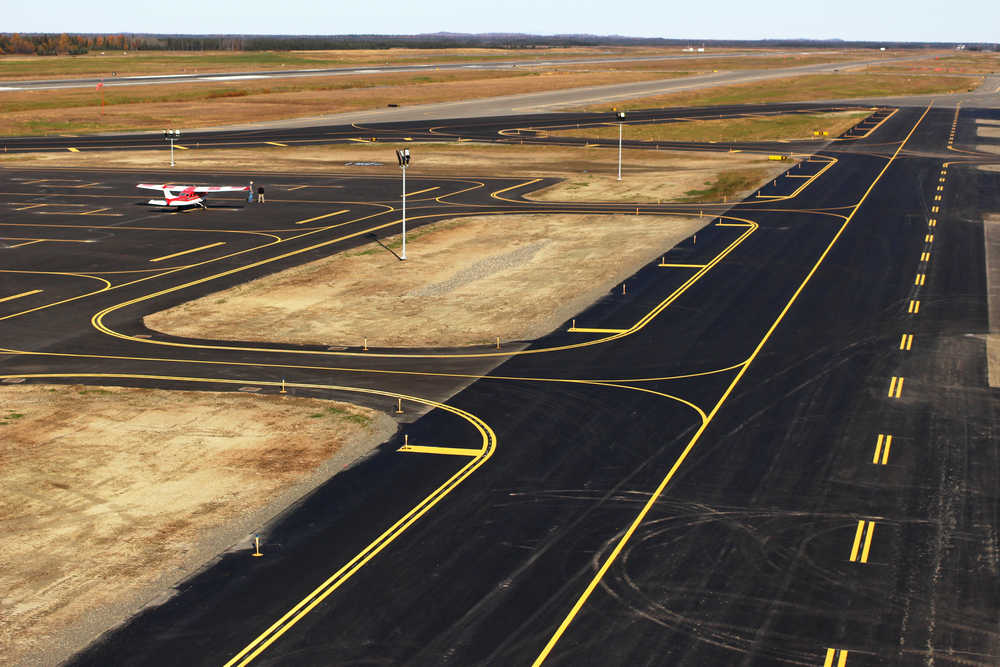Editor’s note: This story has been changed to correct a misspelling of Derek Leichliter’s name.
The Kenai Municipal Airport’s freshly paved tie-down lot and taxiways were ceremonially put into operation with a ribbon-cutting on Thursday.
Kenai Airport Manager Mary Bondurant said that of the Kenai Airport’s 14 taxiways (designated A through M, or Alpha through Mike) that let planes travel between hangars and the runway, three have been rehabilitated for roughly $2 million, $1.9 million of which was granted by the Federal Aviation Administration.
When the Kenai airport was built as a World War II-era military airbase, its runways and taxiways were laid with more concern for haste than longevity.
“It looks like they (Kenai Airport’s runway builders) dug some of the fill out of the taxiway and pushed it over there for the old runway, and then back-filled with garbage — trees, mud, swamp and moss,” said Jim Bielefeld, owner of the charter flight business Kenai Aviation.
The old taxiway has since been buckled by the seasonal freezing and thawing of the ground, creating dips, mounds and cracks.
Bielefeld, who inherited Kenai Aviation from his father Robert Bielefeld, said he grew up on the Kenai airport and remembers learning to ride a bike on the old taxiway. He estimates he now takes planes down Taxiway G from Kenai Aviation’s lot to the runway about three to five times per day and said the trip has sometimes been rough.
“There were times when going through a bump, all three wheels would be off the ground, as well as the tail skid,” Bielefeld said. “It was a real dip. But no damage.”
Engineer Kirk Hollingsworth of the Kenai-based engineering firm Wince-Corthell-Bryson led the renewal project. He said the old taxiway’s susceptibility to frost heave was due to the foundation of buried debris below it, which persisted despite the various repavings — most recently in the 1980s — that were laid on top of it. For the present refurbishment, Hollingsworth dug out the foundation of rotten wood and debris and replaced it with sand and gravel — materials which Hollingsworth said hold little water and so are less likely to frost.
Lighting design was another part of the project. The marker lights bordering the taxiway were previously mounted on two-foot tall posts.
These were replaced by lights embedded in the pavement, which are in no danger of being knocked over by trucks or snow plows.
The lamp posts that lit the tie-down lot were also replaced with posts that are shorter and lamps that are more directional, so as not to cast light into the surrounding neighborhoods. The wiring of the old lightpoles was another relic of old engineering practices — digging beneath, electrical contractor Derek Leichliter of Legacy Electric found them wired directly into a Homer Electric Association power transformer with no cut-off point, creating the potential to damage the transformer and cause a power outage if the airport had ever produced a surge.
Kenai airport operations specialist Matt Landry said replacing the high-pressure sodium lightbulbs of the old lightpoles with LEDs was not only more energy efficient, but saves on maintenance. Landry counted 507 lightbulbs on the airfield that his department is in charge of changing.
The 354 lining the taxiway are LEDs installed about 11 years ago, while the 103 lining the runway are older incandescents. Landry said the only LED bulbs he’s changed since their installation have been damaged ones, while the incandescent lightbulbs burn out and needed replaced about every 4 months.
Though most of the renovation was funded by the FAA, Bondurant said the remaining $130,810 — equal to 6.25 percent of the project cost — came from Kenai’s Airport Improvement Capital Project Fund and was unanimously appropriated by the Kenai City Council at their meeting on May 4, 2016.
Bondurant, Bielefeld, Hollingsworth, Leichliter, and other contractors and airport employees gathered on the tie-down lot for Thursday’s ceremony. Moments after Bondurant and Kenai City Council member Henry Knackstedt cut a red ribbon over the taxiway, Bielefeld parked one of his company’s single-engine planes in the new tie-down lot. Getting out, he examined the fresh pavement.
“I’d like to come out here and ride my bike on this,” Bielefeld said.
Reach Ben Boettger at ben.boettger@peninsulaclarion.com.

